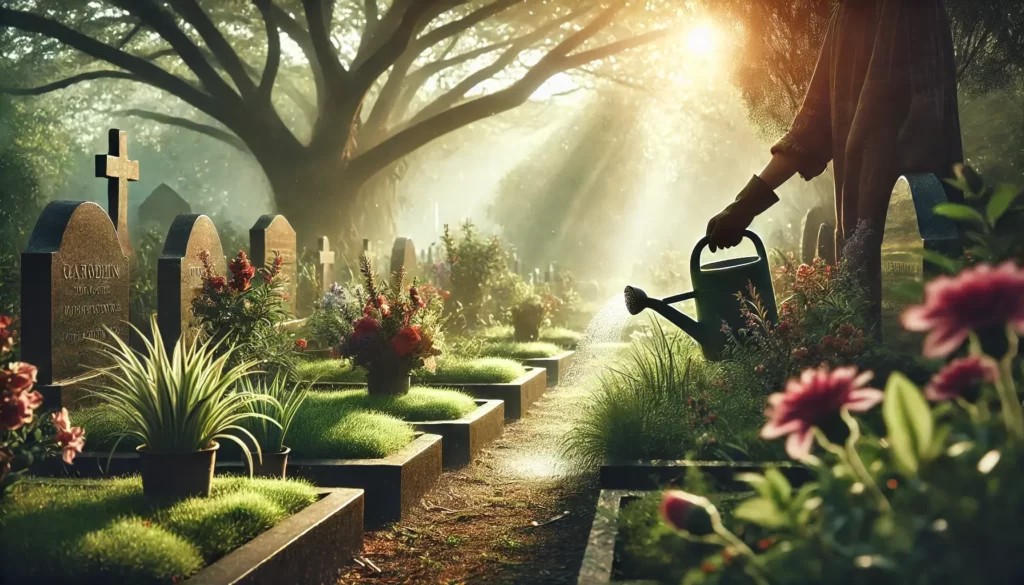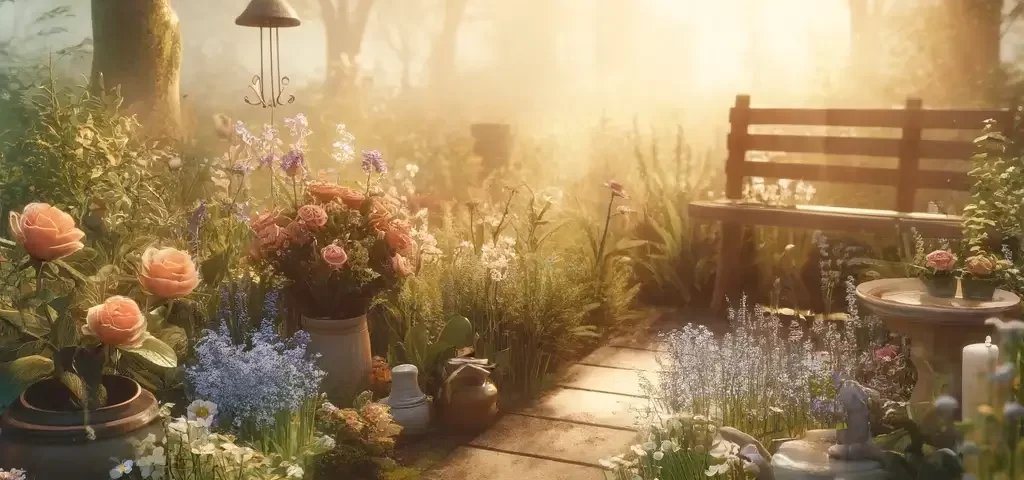How to Create a Memorial Garden to Honor a Loved One

The Benefits of Grief Support Groups: Finding Comfort in Community
October 4, 2024
Incorporating Family Heritage into Funeral Services
October 4, 2024The act of constructing a memorial garden is an exquisite method of preserving the memory of a dear one. A memorial garden can exist in the form of a little patch in the backyard or in an extensive area as it offers a calm refuge that allows you to contemplate, recover and celebrate the life of the departed. Thereafter the garden with careful design becomes an active memorial which includes suitable plants and embellishments in honor of the thoughts and ideas of the individual. In this article, we will look at some ideas for a memorial garden as well as the ways to create such a space that will be dedicated to people in a respectful and dignified manner.
Choosing the Location for Your Memorial Garden
When selecting a location to create a garden for a loved one’s memory, it’s essential to think about both the practical and personal aspects. The location can significantly influence the atmosphere and longevity of the garden, so it’s important to consider various factors:
- Available Space: Whether you have a small backyard or a larger outdoor space, choose a spot that feels right to you. Some people prefer a quiet corner, while others may dedicate a more prominent area to their tribute garden for the deceased.
- Climate and Environment: Because different plants flourish in different circumstances, one should take their surrounding climate into consideration while creating a garden. If frostbite is a common occurrence in your region’s cold geography, then go for frost hardy plants, while warmer regions tend to have more range of flowering plants.
- Sunlight and Shade: Observe the amount of sunlight the chosen area receives. Some memorial garden ideas involve plants that thrive in full sun, while others may require a balance of sun and shade. Ensure the plants you choose will have the right conditions to thrive.
- Privacy and Reflection: It is sometimes advisable to choose a location for your memorial garden that is away from the busy areas which enhances the chances of quiet and personal contemplation. Whist it may be kept away from everyone or placed in an open area, ensure it is somewhere you find comforting.
- Accessibility: Consider how easy it is to reach the garden. You may want a location that’s easy to access, especially if family members or friends will also visit to remember the deceased.
Selecting the Right Plants and Features
Selecting plants with significance or symbolism from the family or relatives of the deceased can enhance making a memorial garden more worthwhile. There are certain plants that are known to signify memory and love and there are flowers that perhaps may be the favorite of the deceased or the color of the flowers might be their favorite.
Plants for the Garden
Here are some popular plant choices that can serve as living tributes:
- Forget-Me-Nots: These delicate flowers are an iconic symbol of remembrance, making them a meaningful addition to any garden for honoring the deceased.
- Roses: Roses are the most overused yet the most cherished representations of affection. Roses come in different shades, and each signifies something different. The color red in roses means true love while in white roves it depicts health and tranquility.
- Lilies: Often used in funerals, lilies represent purity, and peace, making them a fitting choice for planting a memorial garden.
- Lavender: Known for its calming scent, lavender symbolizes serenity and devotion, which can add a soothing atmosphere to the space.
- Daffodils: These cheerful flowers bloom in early spring and can represent renewal and hope, serving as a reminder of the cycle of life.
- Hydrangeas: Through their incredible beauty and ornate appearance, these big, healthy flowers are able to convey deep feelings and appreciation and serve to enhance the garden for the deceased.
Personal Touches for Your Memorial Garden
Beyond plants, adding personal elements to your memorial garden can make the space even more unique and reflective of your loved one. Here are some ideas for incorporating features into your garden:
- Wind Chimes: Wind chimes can produce melodious sounds that can augment the ambience of a space and as such instill a sense of relaxation and warmth.
- Memorial Plaques or Stones: Memorial plaques made of stone bearing the name of the deceased and a related quote can be the center piece of the garden you intend to beautify. Engraved boulders can be placed in the course of the garden to signify specific areas as well.
- Benches or Seating: The addition of a bench or a seating area creates a spot for you or your guests to be still and reflect on the deceased in a peaceful environment.
- Bird Feeders or Birdbaths: Putting up a few bird feeders or baths however not only helps in keeping some wildlife within the premises but also represents the cycle of life. The sounds of the birds within the vicinity help in maintaining peace in the area.
- Fountains or Water Features: A feature that has running water such as a small water fountain can also help improve the calming effects of the garden as it brings about the sounds of water that are meditative and induce focus and peace.

Designing the Layout of The Garden
The arrangement of the memorial garden is as crucial as the selection of plants, materials, and sculptures used. Memorial garden ideas created with proper landscaping techniques makes it possible for one to honor the memory of a loved one fully.
Tips for Designing a Remembrance Garden:
- Paths and Walkways: Consider adding a pathway that meanders through the garden, leading visitors to significant points or features. You can use gravel, stepping stones, or even wood chips to create a natural and inviting walkway.
- Plant Groupings: Arrange plants thoughtfully, grouping them by color, symbolism, or bloom season. For example, placing white lilies around a central bench can create a peaceful and calming atmosphere.
- Personal Corners: Create small sections within the garden dedicated to specific memories. Perhaps one corner can have your loved one’s favorite flowers, while another can feature a memorial plaque or a favorite piece of garden décor.
- Balance of Elements: Seek to achieve an equilibrium between ornamental vegetation, flowering plants, and embellishing components. An equilibrium in design will ensure that the garden gives an impression of a space, and not just a haphazard arrangement of plants and installations.
- Seasonal Considerations: When Planning a Garden Include both native and non-native plants so that whichever the season, the flowering plants always change and are present. Plants such as hydrangea shrubs and rose bushes while fairly dependable due to their ability to come back year after year.
DIY Memorial Garden Tips
Memorial garden ideas don’t have to transform into expensive or overwhelming project. With a little creativity and some thoughtful planning, you can create a garden for a loved one’s memory on a budget. Here are some DIY tips for crafting a beautiful, meaningful space:
- Employ Reused or Recycled Components: Use materials you have at your disposal, like cracked flower pots, old bricks, or stones. You may also transform ordinary household objects into flower pots and garden ornaments to enhance the beauty of your garden.
- Start Small: Tackle a third of your compound first and progress with the other two thirds when time permits. The inclusion of plants or features will be done in phases making the realization of the garden less daunting and allowing it to develop organically..
- Mix Perennials and Annuals: Perennials provide structure and continuity, while annuals add seasonal color and variety. This combination can keep the garden interesting throughout the year.
- Personal Contributions: Involve friends and family in the garden’s creation. Ask them to contribute plants, decorations, or personal items that remind them of your loved one, making the garden a shared tribute.
- Create Memory Markers: Use small stones or plaques to mark special plants or areas of the garden. These can serve as reminders of specific memories or milestones related to your loved one.
Maintenance and Care for the Garden
Once your memorial garden ideas are fulfilled and the garden is planted, regular care and maintenance are essential to keeping it beautiful and thriving. Just like any garden, it will require attention to ensure it remains a peaceful, welcoming space.

Simple Maintenance Tips for a Memorial Garden:
- Watering Schedule: Formulate an irrigation program that is consistent with plant needs. First, assess the weather, considering some plants may require additional watering during the hot and dry seasons while for some, little moisture is in excess.
- Pruning and Deadheading: Regularly trim excessive growth on plants and clear out old blooms to keep your garden neat and healthy. This will promote additional growth, ensuring that your garden remains appealing at all times.
- Weed Control: Weeding should not be neglected to avoid other unwanted plants from invading the garden. Alternatively, employing mulch or cover plants is more effective in lessening the weeds.
- Seasonal Care: some trees or shrubs may be more demanding than others. For example, you may have to protect vulnerable plants from frost or even keep certain potted plants inside during winter.
- Involving Family and Friends: The work in the garden can also be done with other people. This encourages family or friends to partake in gardening as a means of connecting with the dead and aiding in the healing process.
FAQs on Memorial Gardens
1. How to make a memorial in the garden?
To make a memorial in the garden, start by choosing a meaningful location. Then select plants, features, and personal touches that reflect your loved one’s memory. Finally, arrange the space to create a peaceful and reflective environment.
2. What is a memorial garden?
A memorial garden is a specific place set up in memory of a person, usually someone who has died. It very often contains some representative plants, personal belongings, and such items as seats or tablets, serving as a calm venue for introspection and commemoration.
3. What plant is best for a memorial?
Since they carry messages of memory, affection and serenity, flowers like forget-me-nots, roses, lilies and lavender are widely used in memorial gardens. Select a flower that speaks to you and suits that individual’s memory.
4. How does a garden of remembrance work?
A remembrance garden is an area set up in honor of those who have passed away. It is helpful in that it creates a calm and tranquil atmosphere where people can go to pay their respects and have a quiet moment of thought and recollection, often including personal touches such as inscriptions, plants, or other monuments.


